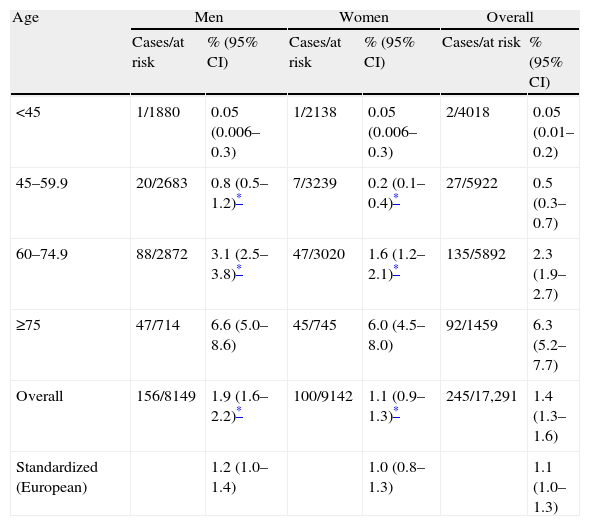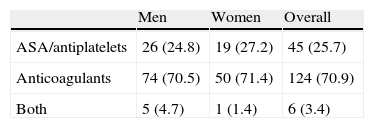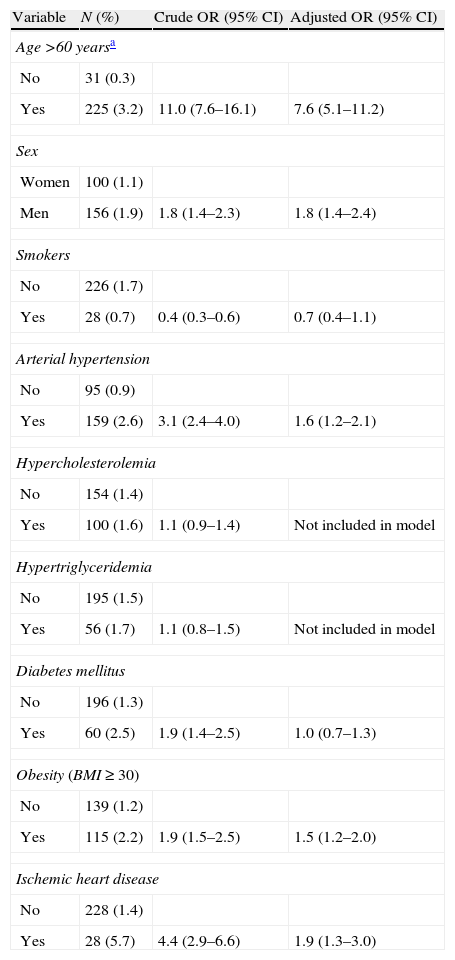Atrial fibrillation (AF) is the most common type of arrhythmia.
The purpose of this study was to determine the prevalence of atrial fibrillation and its relationship with cardiovascular risk factors in Spain.
MethodologyCross-sectional study based on a grouped analysis of 17,291 randomized individuals recruited in 6 population studies.
ResultsThe prevalence of atrial fibrillation was 1.5% (95% CI: 1.3–1.7%). Men had a greater prevalence of the disease than women (1.9 vs. 1.1%, respectively). The prevalence of atrial fibrillation progressively increased with age: 0.05% for patients younger than 45 years, 0.5% for those between 45 and 59 years of age, 2.3% for those between 60 and 74 years of age and 6.3% for those older than 75 years. The percentage of individuals who underwent anticoagulant treatment was 74.3%. The risk factors significantly associated with arrhythmia were ages older than 60 years (odds ratio [OR]: 7.6; 95% CI: 5.1–11.2), the male sex (OR: 1.8; 95% CI: 1.4–2.4), arterial hypertension (OR: 1.6; 95% CI: 1.2–2.1), obesity (OR: 1.5; 95% CI: 1.2–2.1) and a history of coronary artery disease (OR: 1.9; 95% CI: 1.3–3.0).
ConclusionAtrial fibrillation is a common disease in elderly individuals, while its prevalence is low in individuals younger than 60 years. Most individuals with atrial fibrillation were on anticoagulant treatment. The risk factors for this type of arrhythmia are age, the male sex, hypertension, obesity and a history of coronary artery disease.
La fibrilación auricular es la arritmia crónica más común.
El propósito de este estudio fue determinar la prevalencia de la fibrilación auricular y su relación con los factores de riesgo cardiovascular en España.
MetodologíaEstudio transversal a partir de un análisis agrupado de 17.291 individuos aleatorizados reclutados en 6 estudios poblacionales.
ResultadosLa prevalencia de fibrilación auricular fue de 1,5%. (intervalo de confianza 95%: 1,3–1,7%). Los hombres tuvieron mayor prevalencia que las mujeres (1,9 vs. 1,1%, respectivamente). La prevalencia de fibrilación auricular se incrementó progresivamente con la edad: 0,05% en los menores de 45 años, 0,5% entre los 45–59 años, 2,3% entre los 60–74 años, y 6,3% en los mayores de 75 años. El porcentaje de individuos que recibía tratamiento anticoagulante fue de 74,3%. Los factores de riesgo asociados significativamente con la arritmia fueron: edad mayor de 60 años (odds ratio [OR]: 7,6; IC 95%: 5,1–11,2), sexo masculino (OR:1,8; IC 95%: 1,4–2,4), hipertensión arterial (OR:1,6; IC 95%: 1,2–2,1), obesidad (OR:1,5; IC 95%: 1,2–2,1), y antecedentes de enfermedad coronaria (OR:1,9; IC 95%: 1,3–3,0).
ConclusiónLa fibrilación auricular es una enfermedad frecuente en los individuos de mayor edad mientras que su prevalencia es baja en individuos menores de 60 años. La mayoría de los individuos con fibrilación auricular estaban bajo tratamiento anticoagulante. Los factores de riesgo para padecer esta arritmia fueron la edad, el sexo masculino, la hipertensión, la obesidad y los antecedentes de enfermedad coronaria.
Article
Diríjase desde aquí a la web de la >>>FESEMI<<< e inicie sesión mediante el formulario que se encuentra en la barra superior, pulsando sobre el candado.

Una vez autentificado, en la misma web de FESEMI, en el menú superior, elija la opción deseada.

>>>FESEMI<<<









